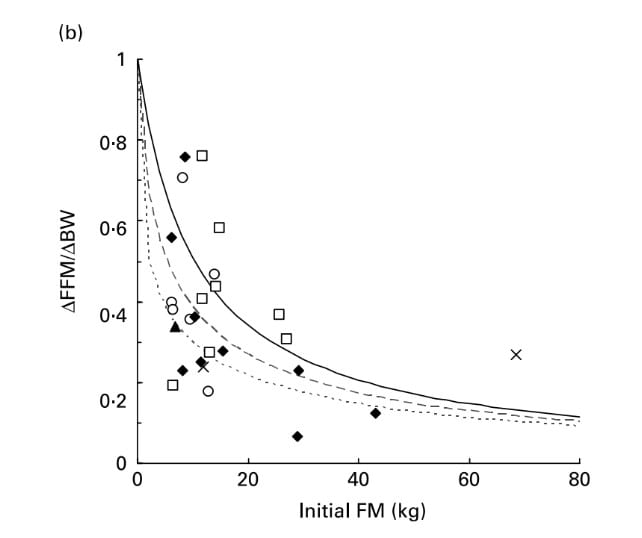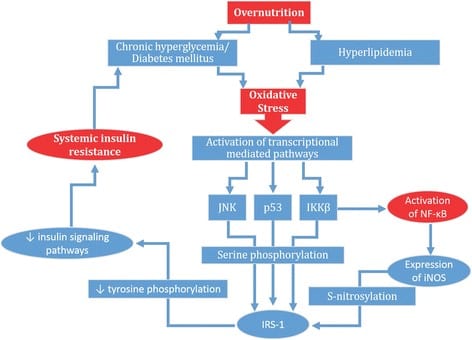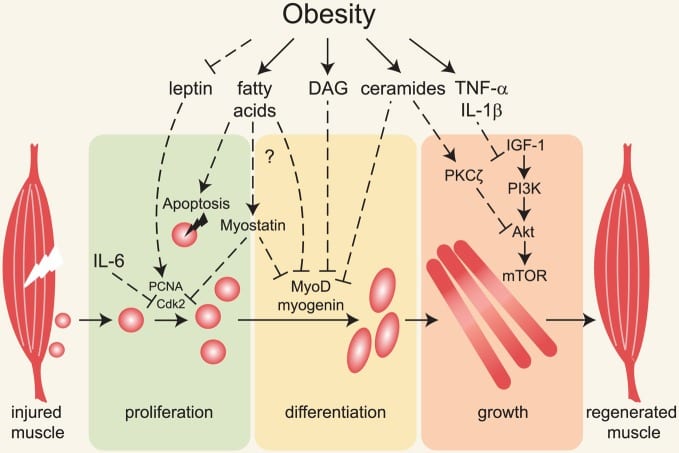What’s the optimal body fat range for muscle growth?
Cut or bulk? Many people see this simply as a question of personal preference, and of course to a large extent it is. However, there is also evidence that nutrient partitioning – how your body uses the nutrients you consume – is affected by your body fat level. Specifically, higher body fat levels may induce anabolic resistance and impair muscle growth. An energy surplus may thereby result in a more favorable ratio of muscle to fat gain in leaner individuals, whereas obese individuals may be prone to store most of their energy surplus as fat. In other words, if you want to make lean gains, you may need to stay lean.
Recently, Eric Trexler, with input from Greg Nuckols, critiqued this theory, effectively trying to debunk it. In this article I’ll critique their critique, and I look forward to the critique of my critique of their critique to critique in the spirit of scientific debate. I consider Greg a friend and a highly respected colleague, and I’m also getting to know more good things from Trexler. We’re actually co-authors on an upcoming paper. I won’t call him Eric, because when I say Eric, I usually mean Eric Helms and I think Trexler sounds better than Second Eric. Maybe a more royal Eric The Second? Anyway, they’re great guys, and I recommend following them. As to the matter at hand, since their critique runs counter to what I’ve argued a few times, I’ve already received multiple questions from students, clients and readers about their article and podcast on this topic. They put forth great arguments and it’s a very interesting topic with significant practical relevance, so let’s get into it.
Update/correction: It came to my attention that StrongerByScience is now co-owned by Eric rather than being solely Greg’s website, and while they discussed the topic a few times and Greg came up with the idea for the analysis and helped with the data collection, the article was written by Eric, so Greg felt he should not be named as a co-author. My apologies to Eric if listing Greg as a co-author came across as dismissive of his contribution.
P-ratios in sedentary individuals
The most direct empirical evidence on the effect of body fat level on nutrient partitioning comes from a paper by Forbes (2000), replicated by Hall (2007). Put simply, they found that overall in the literature, leaner individuals had a better ratio of lean to fat gain in energy surplus than fatter individuals. The graph below summarizes the updated results of Hall (2007).

The fat-free proportion of the body weight change (dFFM/dBW) as a function of initial fat mass (FM) during weight gain: leaner individuals seem to make leaner gains in energy surplus. Source
Trexler rightfully noted that there are several limitations of the above data that prevent us from extrapolating this relationship between body fat percentage and p-ratios during overfeeding directly to bulking strength trainees. First and foremost, the data are on sedentary individuals, not training individuals. However, if fat related factors in our body affect nutrient partitioning measurably even in sedentary individuals, you could also argue that these effects could be even more pronounced in strength trainees, where the potential for muscle growth is of course far greater. The more mass you gain, the more important the ratio becomes.
Second, the relation goes both ways: leaner individuals are also at greater risk of muscle loss. However, this is where strength training could make a crucial difference. Sedentary individuals will almost always lose both muscle and fat in energy deficit (typically 25% of weight loss is lean mass) while gaining both muscle and fat in energy surplus (mostly fat of course). However, this is no longer the case in strength trainees. As I showed in a previous article, it’s very possible to gain muscle and lose fat at the same time. In fact, muscle loss while cutting outside of contest prep is often a sign someone’s program is very suboptimal. Muscle retention is far easier to achieve than muscle growth.
So what happens in strength training individuals? Ideally we would like to look at a study in which obese individuals are put into 2 groups: one group bulks for 6 months and then cuts for 6 months, the other group does the opposite order. At the end we see who made better gains in total. Unfortunately, such a study does not exist and is not likely to exist for a while, so we have to rely on other lines of evidence.
The rodent study
Trexler & Nuckols cite De Sousa et al. (2020) as evidence against a relation between body fat and muscle growth potential. “A new rodent study indicated that a Western diet and a high-fat diet promoted similar degrees of obesity in mice, but only the high-fat diet significantly inhibited hypertrophy in response to muscular overload. This would indicate that gains during this rodent “bulking phase” were not negatively impacted by obesity per se, but rather by the composition of the high-fat chow[…]”
I feel this study is misrepresented. The diets did not in fact promote similar degrees of obesity. The high-fat diet induced a 60% increase in bodyweight, significantly greater than the 36% in the Western group. Both these weight gain rates were significantly greater than the standard chow group’s weight gain. Moreover, the high-fat diet group gained not only by far the most weight but also significantly more fat than the other groups. And it was the only group to develop glucose intolerance and insulin resistance. So there was actually a clear hierarchy of bodyweight and fat gain: high-fat > Western > chow.
The mice fed the high fat diet achieved the poorest muscle growth in the next overloading phase. The Western diet group showed impaired muscle growth midway through the study but not at the end of the study, compared to the standard chow diet. So overall, it seems that the fatter the mice got, the worse their subsequent gains. I’d say this study is actually strong proof of principle that getting too fat can reduce your gains.
It also makes sense that muscle growth was most consistently blunted in the group with the worst carb tolerance, which brings us to the mechanism of how excess body fat could impair muscle growth.
Why body fat may blunt muscle growth
Trexler note that there is no established mechanism by which high body fat levels would interfere with muscle growth. They rightfully point out that the most commonly purported mechanism of insulin resistance is shaky. For insulin resistance per se to directly impair muscle growth, the muscle tissue would have to be more insulin resistant than the fat tissue. In this case, insulin could indeed shuttle more nutrients into fat than muscle. There’s little evidence supporting this mechanism, so I agree it’s not very compelling, although it may play a role in carb intolerant individuals. Outside of carb intolerant individuals, insulin sensitivity doesn’t seem that relevant and most theories surrounding it have been debunked.
However, I think Trexler missed a substantial literature on indirect effects of insulin resistance. Insulin resistance significantly correlates with systemic inflammation, because high blood sugar and certain fatty acid levels stimulate reactive oxygen species (ROS) production, causing inflammation. Inflammation in turn causes insulin resistance by i.a. metabolic stress on the pancreas. Insulin resistance exacerbates the rise in blood sugar levels, which causes a reinforcing effect on the whole cycle. This is part of the reason diabetes is not just a blood sugar handling disorder but typically associated with a host of other health problems as well. The figure below gives a mechanistic overview of the relation between overeating, inflammation and insulin resistance.

How overeating causes insulin resistance and inflammation.
Crucially, there is a compelling literature showing high systemic inflammation levels can reduce muscle growth. Inflammation seems to function in a signal-to-noise manner, which means high systemic inflammation masks the acute inflammation signal for muscle repair after training. Your muscles may be shouting “Help, we’re inflamed!” after your workouts, but the rest of your body’s like “Who isn’t? Get in line.” If you’re not familiar with this literature, I highly recommend you read my article on the relationship between inflammation and muscle growth.
So we actually have a compelling mechanism of how body fat can impair muscle hypertrophy: systemic inflammation. While insulin resistance isn’t likely directly relevant for individuals with normal carb tolerance, the associated inflammation may be a much bigger problem for muscle growth.
Protein balance in obese individuals
Trexler acknowledges that there is a literature showing anabolic resistance in overweight individuals in terms of protein balance. Specifically, a 2019 review paper by Beals et al. concluded overweight individuals tend to have lower rates of total muscle and myofibrillar protein synthesis after eating than lean individuals. While not every study finds significant differences, multiple studies find negative effects and none show positive effects of being overweight.
Trexler counters this evidence of anabolic resistance by citing Murton et al. (2015): “However, obese people also appear to have lower rates of muscle protein breakdown, so net protein balance (the actual determinant of net accretion or loss of muscle tissue) doesn’t seem to be much different[…]”
In fact, protein balance was literally twice as high in the lean group vs. the overweight group in Murton et al.’s study. While the study had problems with statistical power, myofibrillar protein synthesis levels doubled in the lean group after ‘eating’ (infusion of nutrients) yet showed no increase in the overweight individuals. Protein breakdown levels tended to decrease more in the overweight group, but total net protein balance was still twice as positive in the lean group after accounting for this. In general, protein synthesis levels can vary much more than protein breakdown levels, so decreased protein synthesis is generally very bad news for muscle growth.
Moreover, it’s certainly not an established finding that overweight individuals have lower protein breakdown levels. In fact, other research finds increased levels of protein oxidation in overweight compared to lean individuals.
In addition to anabolic resistance after eating, overweight individuals have also been found to have anabolic resistance to strength training. Beals et al. (2018) found reduced myofibrillar protein synthesis levels in overweight vs. lean individuals after a strength training workout combined with protein consumption. There was no anabolic resistance to sarcoplasmic protein synthesis, which may explain why Hulston et al. (2018) found no evidence of anabolic resistance in overweight individuals for mixed muscle protein synthesis. Trexler largely writes off these 2 study findings as ‘inconsistent’, but I’d say the overall trend in the literature is decidedly negative for overweight individuals.
Recovery capacity
Trexler argues there is no more evidence than they and I’ve discussed so far to support an effect of body fat level on muscle growth potential or nutrient partitioning. However, being overweight also affects recovery capacity in some research. In animal and in vitro research, we see significant detrimental effects of obesity on muscle recovery capacity. A human study on handgrip strength testing found evidence of reduced stress tolerance and greater fatigability in obese vs. lean individuals. Poor carb tolerance has also been directly linked to poorer adaptations to training, at least during endurance exercise. The illustration below summarizes plausible mechanisms by which being overweight may negatively affect muscle recovery.

Obesity negatively affects multiple pathways of muscular recovery. Source
Anabolic hormonal health
Another mechanism by which both too high and too low body fat levels can impair nutrient partitioning is our hormonal health. Trexler does not not discuss this, but I think it’s relevant in the long term. A high body fat percentage lowers androgenic anabolic hormone and growth factor levels, particularly in men, along with increased cortisol [1, 2, 3, 4, 5]. Men are particularly susceptible to developing low testosterone levels when they are obese, because fat tissue aromatizes (converts) testosterone to estrogen. Many obese men even develop clinical hypogonadism (low testosterone), a phenomenon called Male Obesity-related Secondary Hypogonadism. In line with hormonal health, there is a negative dose-response relation between body fat percentage and fertility if your BMI is over 18.5. For a 21-year-old, the optimal fat level for fertility corresponds to a body fat percentage of just 10.7% for untrained men and 21.5% for women based on this. This estimate for fertility corresponds with the ideal body fat level for testosterone and growth hormone in men: both anabolic hormone levels negatively correlate with body fat percentage between 12-47% [2] (no data on leaner subjects).
Some people argue differences in testosterone level do not influence muscle growth, but I disagree with that. Most of those critiques are based on inter-individual differences, which are meaningless due to differences in individual androgen metabolism. Within individuals, the literature is quite consistent that there is a positive dose-response relation between someone’s testosterone level and their potential for muscle growth. This is particularly clear during testosterone replacement therapy. At the very least, there should be little doubt that full-blown hypogonadism is no bueno to get jacked.
Indirect lines of research
Trexler draws on a commendable body of indirect research to investigate if high body fat levels interfere with our ability to make lean gains. However, I think this literature is simply too indirect and confounded to draw any conclusions from. Almost all these studies look at individuals with different diets and training programs. So I think the only thing we can take away from these findings is that someone’s body fat percentage is not nearly as important as their diet or training, which I think nobody will argue with, although it may be worth emphasizing. Concretely:
- The finding that the many of the most muscular athletes are the fattest ones says nothing about nutrient partitioning. It simply reinforces the quite well-established finding that our maximum muscular potential is higher at higher body fat levels. Our bodies seem to allow us to carry more muscle when we also carry some more fat. Also, when you get to the super heavyweight sports, like sumo wrestling, quite some success comes down to your ability to force-feed. People that can consistently consume inhuman quantities of calories end up the most muscular and the fattest. P-ratios don’t really enter into it for most of these athletes.
- Comparisons between different positions of American football players are confounded by numerous factors. First, there’s huge selection bias here. For example, the prototypical hardgainer probably doesn’t want to be or is going to be selected to be a lineman. The athletes at different positions also have different exercise requirements, if not in the gym than at least on the field, and they tend to eat differently. Few of these studies have any diet controls and the rare ones that do typically suffer from atrocious adherence rates. Even many pro athletes are notorious for barely following their coaches’ diet recommendations. Their body fat percentage is a small factor among the major variables between players in terms of their genetics, training and diets.
- Post-competition weight regain is again majorly confounded by several factors. First and foremost, after a competition many competitors binge the crap out of themselves. They’re not exactly in the ‘lean bulking’ mindset. Plus, this population actually likely has too low a body fat percentage: their hormonal health is shot. Even still, many bodybuilders talk about the ‘anabolic rebound’ after cutting or contest prep, so anecdotal evidence goes both ways.
- By far the most interesting data comes from Trexler & Nuckols’s own unpublished meta-analysis. However, again here we have so many confounders you’d need major effect sizes and huge sample sizes to tease out any effects of less important variables like body fat percentage.
- As they acknowledge, they did not perform a systematic review, so there’s again potential for bias in study selection (though not consciously: I trust these guys absolutely).
- We’re looking at 1 variable in studies that were about something else, so you get major confounding effects. For example, did they gain more muscle because they were leaner or because they were in the group with the more effective training protocol? This should average out in theory, but epidemiological research shows us this is often not the case in practice, especially not in studies with around 20 subjects.
- The analysis did not control for baseline muscle mass or training status, which obviously affects the rate of muscle growth. Lesser trained individuals may on average have more fat and less muscle and gain more muscle in a study, which would show up as a positive relation between body fat level and muscle growth.
- They grouped men and women together. You cannot compare body fat percentages between men and women directly due to genetic differences in body fat storage patterns and essential fat levels. 10% Body fat is a nice sixpack level body fat for men, whereas most women at this body fat level are in a coffin or misguided by erroneous body fat measurement methods. Female essential body fat levels are around 12%.
- Most of these studies had no diet control. If people that eat more tend to have higher body fat levels and a greater likelihood of ending up in energy surplus, we can again get a positive relation between muscle growth and body fat percentage purely mediated by energy intake.
- Lack of control for energy balance is a particularly major confounder considering their use of a ‘lean gains’ metric, defined as the change in fat-free mass minus the change in fat mass, rather than actual p-ratios, because it’s much easier to lose fat than to gain muscle. In studies without diet control, we typically see that some subjects lose bodyweight and fat, whereas others gain weight and probably more muscle. The ‘lean gains’ metric would majorly reward people ending up in energy deficit, even though we are actually mostly interested in muscle growth.
- Overall, I think a meta-analysis like this only has much promise if it systematically includes diet-controlled studies of a relatively homogenous population in energy surplus with considerable sample sizes. Then maybe we can observe a relation between the individuals’ p-ratios and their starting body fat level. Currently I’d again say all we can see now is that your body fat percentage is not as important as your genetics, training program, diet or lifestyle, which is in itself a valuable finding but not particularly controversial.
Conclusion
Overall I think Trexler & Nuckols were a bit quick to dismiss the theory that our body fat level influences our nutrient partitioning. The mechanistic case for the theory is far stronger than portrayed as just the bro intuition that insulin resistance is bad and 2 cross-sectional analyses in sedentary individuals. In addition to a rodent study showing proof of principle, there’s a compelling literature showing high body fat levels can disrupt our hormonal health, cause systemic inflammation, impair muscle recovery capacity and decrease muscle protein synthesis. Health and anabolism go hand in hand. Based on this evidence, I recommend that people training primarily for aesthetic or health reasons stay in the body fat range where these variables are optimal. Unless you have a very compelling reason, such as a target weight class, I see no reason to risk dreamerbulking up to higher levels. The exact range likely varies per individual based on their health, but we can say with reasonable confidence that someone’s most anabolic body fat level is higher than contest shape but below being overweight.
Update: the critique of the critique of the critique
Trexler & Nuckols published a response to my article here. I’ll respond to their comments below.
Regarding the rodent study, the fact is the researchers reported the high-fat diet group gained the most weight and fat, and this was the group that gained the least muscle afterwards. That’s proof of principle that a ‘dreamerbulk’ can interfere with subsequent muscle growth. While their final body fat percentage may not have ended up considerably higher than the other group, they were the only group that developed insulin resistance, which brings us to an important point.
Trexler & Nuckols focus intensely on exact body fat percentages and the exact correlations of it, but this is partly missing the point. Even the bro theory of nutrient partitioning acknowledges body fat percentage per se is not the problem: insulin resistance is (plausibly via the associated inflammation). In practice we can’t directly observe inflammation or insulin resistance or whatever obesity-related problems may interfere with muscle growth, so the idea is that we should stay away from body fat ranges that may cause these problems. BF% is thus just a proxy for the real problem(s).
Regarding inflammation, we seem to agree excess inflammation is clearly bad for our gains. Trexler & Nuckols argue that it’s just unlikely to ever become a problem for an overall healthy strength trainee, because all the research is on older adults. That’s certainly a notable limitation, and it’s safe to say any negative effects would be smaller at lower levels of inflammation, but would they disappear completely? We actually have a study on young, healthy strength trainees that found a negative correlation between a marker of inflammation, baseline Il-6, and muscle growth, but Trexler & Nuckols disregard this due to lack of data reporting.
Regarding protein balance, here too we differ in interpretation. There’s substantial support for anabolic resistance to food in overweight individuals, but in strength trainees, we can summarize the results as 1 study showing anabolic resistance and 1 study not showing it. Trexler & Nuckols are not concerned about this. I’m comfortable saying this is a negative trend in favor or not getting overweight. Significantly reduced muscle protein synthesis can be a big deal.
Regarding recovery capacity, we seem to agree there’s actually considerable evidence overweight individuals have impaired recovery capacity. Trexler & Nuckols argue this is probably not a big deal, as the research is all in untrained individuals and animals. Again I’m not comfortable dismissing all this evidence. Trained individuals have better recovery capacity than untrained individuals, definitely, but would it completely wash it the detrimental effects of being overweight?
On a side note, Trexler & Nuckols found 2 very cool studies that I was unaware of. These studies show that being underweight is bad for neuromuscular recovery as well. That’s exactly in line with my proposed optimum (inverted U) curve of body fat percentage: it’s best to stay in the healthy range. This is yet another big limitation of Trexler & Nuckols’s unofficial meta-analysis: they try to find a linear effect of body fat percentage, whereas they should be looking for a U-curve: there’s probably a positive effect at very low body fat levels (they’re too lean) and a negative effect at high body fat levels (they’re overweight). In the healthy and quite common range of body fat, there will probably be no effect at all, e.g. at 10-15% for men.
Regarding hormonal health, again we differ in the degree of concern. Trexler & Nuckols argue it’s not a big deal for your hormonal health to be overweight. They rightfully show that on average, there’s indeed not a huge negative effect. However, as I showed, and as any fertility doctor should be able to attest to, for some people it is very much a big deal: they can develop clinical hypogonadism by becoming overweight and getting lean can solve the problem.
On a technical note, their analysis of my citation of the subfecundity study is in my view again missing the larger point. To quote the researchers: “Among men and women with a BMI of 18.5 kg/m(2) or more, we found a [negative] dose-response relationship between increasing BMI group and subfecundity”. This relation disappeared at lower body fat levels, so while we can debate how they classified the BMI categories and their conversion to BF%, the data clearly support that being overweight is bad for fertility and the trend is that the more overweight you are, the worse it is. I wouldn’t put too much stock into the exact numbers of 1 study.
In conclusion, I think Trexler & Nuckols are falling a bit into the trap of mistaking absence of evidence for evidence of absence. It would be great if we had a good study on untrained obese vs. lean individuals that would then perform a bulk on the same training programs with the same energy surplus, but alas, we simply do not have any such study. So we’re forced to other lines of evidence. Since we know overweight individuals are more prone to chronic inflammation, impaired recovery capacity, anabolic resistance and suboptimal anabolic hormone levels, I think it’s very reasonable to stay in the healthy range of body fat, even if you don’t care about your health per se, unless you have a very good reason to bulk up higher, like competing at a heavy weight class.
 Want more content like this?
Want more content like this?
Then get our free mini-course on muscle building, fat loss and strength.
By filling in your details you consent with our privacy policy and the way we handle your personal data.
